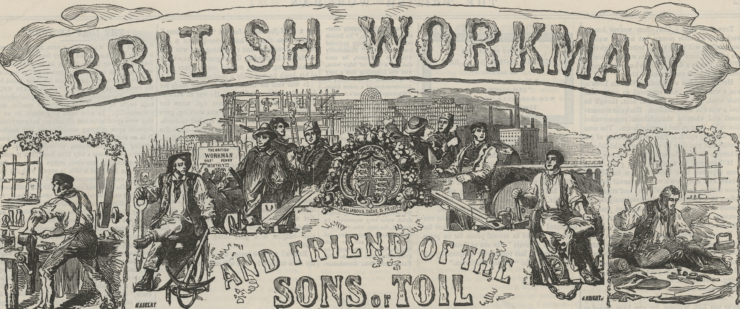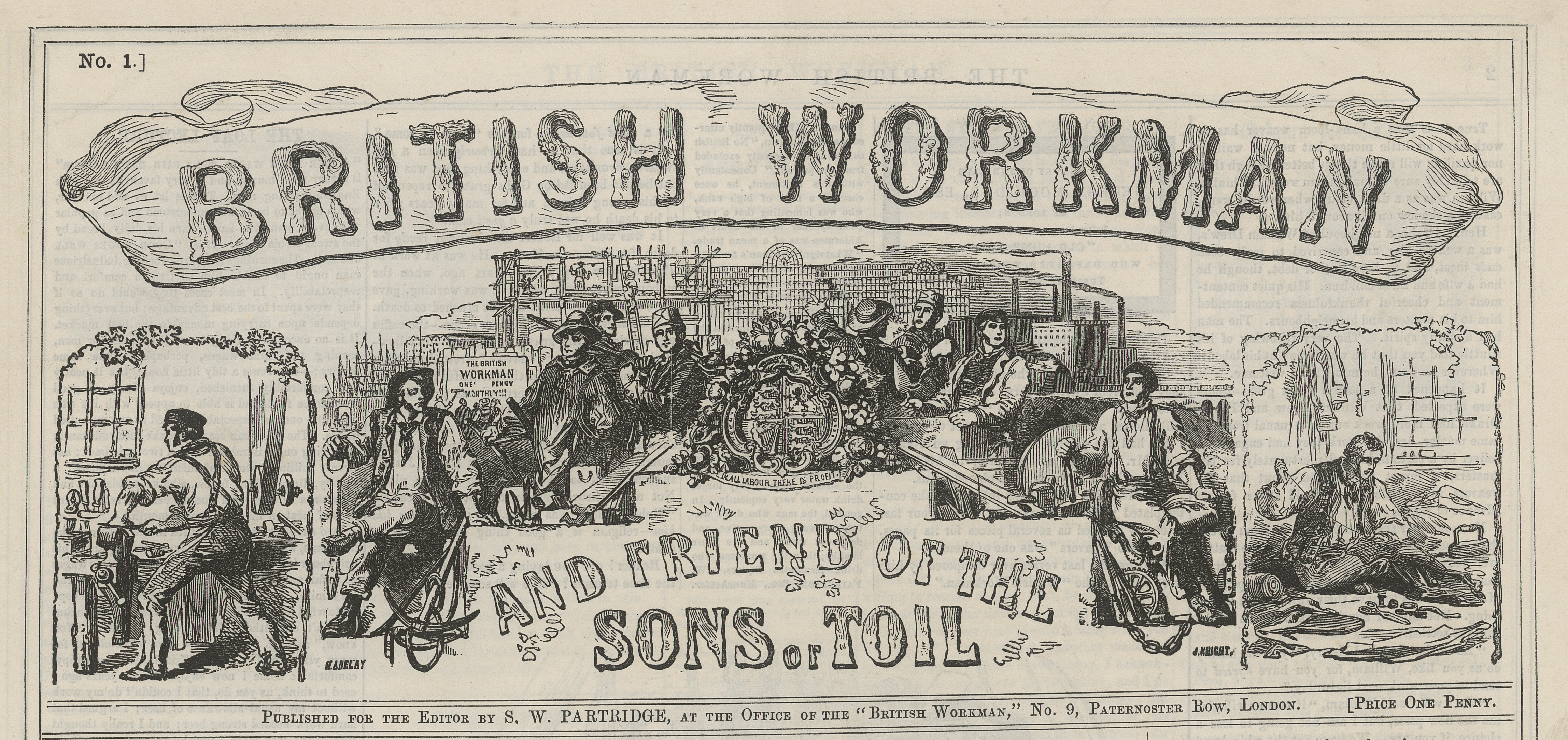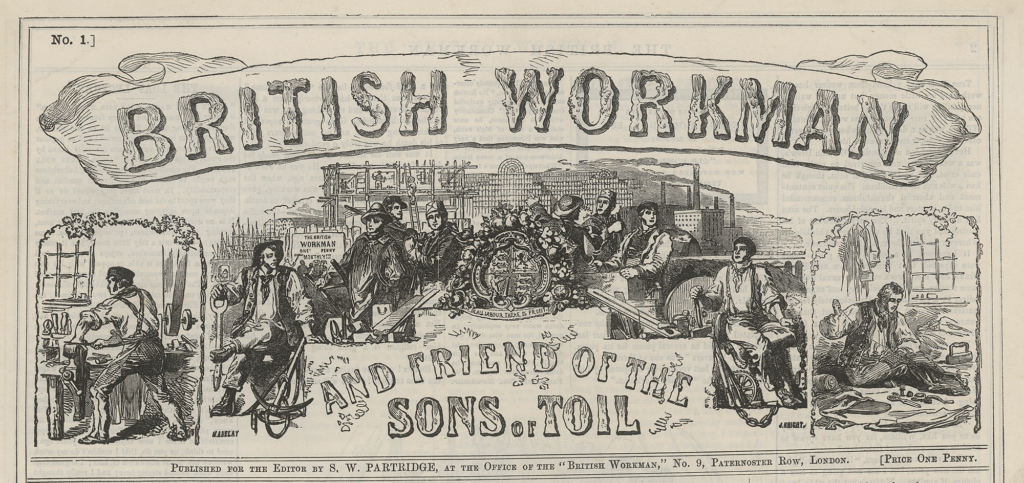Academic Level
Key Stage 3 (UK)
Subject(s)
English Language and Literature
- Interpreting Texts
- Interpreting Images
History
- 19th-Century British History
- History of Industrialisation and Labour Organising
- Child Labour
- Women in the Workforce
- Temperance
Time
- 2 hours (2 1-hour lessons)
Downloadable/Printable Files of Materials on this Page
[dg ids=”147″]
Overview
This two-lesson module focuses on industrialisation in England in the mid-nineteenth century, in particular the impact that it had on ordinary people’s lives. It will explore one specific area of industrialisation: the cotton industry, which had enabled a factory system of spinning or weaving machinery for the production of cotton, yarn, and cloth. This was an extremely important part of the British economy at this time. By the 1830s, approximately 85% of all cotton manufactured worldwide was processed in Lancashire in the Northeast of England. Focussing on the cotton industry provides a strong link with the British Workman paper as the first edition has an article referring to the historically important Preston Mill Strike of 1853-54 and the threat of a broader strike throughout key industries in the UK. The paper provides us with a window on how certain sections of society (the mostly middle-class Temperance movement) viewed the working class as well as a valuable insight into everyday details of domestic, public, political, and economic life at the time. The British Workman paper, published for the first time in 1855, was funded by members of the Temperance movement and was aimed at working-class men.
Teaching Plan
Lesson 1 (1 hour): Women, Industrialisation, and the Temperance Movement
Segment Activity Timing Class Organisation Purpose Introduction Introduce subject 10 minutes Plenary Introduce the subject of industrialisation and the focus on the cotton industry. Introduce the "British Workman," its relevance to and connections with industrialisation, and the insights it offers. Activity 1 Familiarise students with the paper by examining pictures 10 minutes Working in pairs + plenary discussion Identify images and symbols of industrialisation in the paper's banner logo. Activity 2 Reading/Referencing paper and handouts 15 minutes Working in pairs + plenary discussion Explore the role of women in industrialisation, and explore images of men and women/sexual discrimination/sexism in the "British Workman." Activity 3 Reading/Referencing paper and handouts 15 minutes Working in pairs + plenary discussion Explore the connections between industrialisation and the Temperance movement. Discuss 19th-century and 21-century media similarities and differences. Round-Up Discussion 10 minutes Plenary Review what was covered in the lesson and highlight the important subjects addressed.
Lesson 2 (1 hour): The Preston Strike and the British Workman
| Segment | Activity | Timing | Class Organisation | Purpose |
| Introduction | Introduce subject | 10 minutes | Plenary | Review the previous Lesson and introduce the next focus of discussion. |
| Activity 1 | Reading/referencing paper and handouts | 20 minutes | Working in pairs + plenary discussion | Focus on a specific industrial dispute to explore working conditions and the start of the Chartism/trade union movement. Explore the "British Workman's" position and approach to a labour dispute. Look at immigration during industrialisation. |
| Activity 2 | Reading/Referencing paper and handouts | 20 minutes | Working in pairs + plenary discussion | Look at living conditions during the mid-nineteenth century. Discuss child labour and make connections to child labour in the developing world. |
| Round-Up | Discussion | 10 minutes | Plenary | Review what was covered in the lesson and highlight the important subjects addressed. |
Lesson 1
Show the class a copy of the British Workman. If using a projector, you may want to use the “Zoom & Browse” Interface. Explain that you will be circulating copies (handouts) for them to look at shortly.
It is important to explain early in the lesson that the title of the paper excluded over 50% of the population at this time, i.e., women! Remind the class that this was a period of history where sexual discrimination against women, or sexism as it is often called today, was common across all areas of life, particularly in the workplace, which will be explored in this lesson
Banner heading and logo: The engraved images provide very valuable images and representations of industrialisation, from the workers to the buildings and symbols of industry.
Lesson 1-Activity 1: Images of Industrialisation in the British Workman
Students will:
- look at pictures in detail surrounding the British Workman logo to identify the different types of workers/trades represented; and
- try to identify the buildings and structures behind the workers in the logo illustration; and
- determine what the logo and paper say about the changes in Britain in the 1850s.
Key questions:
- What types of workers/traders are pictured in the British Workman logo?
- What buildings or locations are represented in the British Workman logo?
- Does the British Workman logo say anything about social or industrial changes taking place in Britain in the 1850s?
Discussion ideas:
Workers depicted in logo
- Tool Maker/Grinder–most industrial workers at this time would have required hand tools (no electric drills back then!). The importance of tools is demonstrated by the variety on show: saws, hammers, pliers, mallets, spades, pick axes, planes.
- Builders, Bricklayers, and Railway Workers–all were critical for both building houses and factories at this time, and for amenities, roads, public buildings, etc. From the 1840s, railways were extremely important as they enabled industrialisation to be fully realised, providing fast connections between towns and cities for imports, commodities, and publications like the British Workman.
- Military Men–the Crimean War (1853-54) would have been fresh in people’s minds.
- Farmer–recognising the importance of rural labourers too.
- Tailor–recognising the still high number of workers carrying out hand-crafted trades.
Buildings & Structures in logo
- Houses and Scaffolds–indicate the ongoing pace of house building as well as factory construction.
- Smoking Mills and Factories–suggests both production and the environmental impact of growing consumer culture.
- Crystal Palace–built in 1850, the Crystal Palace was a symbol of industrial price, an innovative use of cast-iron and plate-glass construction, and the site of the 1851 Great Exhibition.
- Tunnels and Bridges–key elements of the railways throughout Britain. Brunel’s 1840 tunnel under the Thames was considered the ‘eight wonder of the world.’
Ships in logo–celebrating Britain’s sea power at this time, the British Empire’s expansion, and imports of goods and raw materials that were critical for the growth of industrialisation.
British Workman in logo–note that the publication name appears in both a banner across the logo and within the illustration as an advertisement boasting the price of one penny monthly
Literacy–literacy levels were steadily increasing during the early nineteenth-century. However, records of literacy levels varied across the country and statistics were not uniformly kept. Record of newlyweds at this time show that approximately 70% of men could read and approximately 55% of women (caution, because this varied across the UK and some regions were much lower). Compulsory education, for both sexes (up to the age of 13) was introduced in 1880. Pictures and drawings were powerful ways of getting messages across that people could relate to and identify with.
Illustrations–illustrations not only appealed to illiterate or less literate readers, they often were transformed into interior decoration. At a time when working class people could not afford the luxuries of home decoration, some of the engraved pictures were designed to be hung up at home (for example, royal portraits appear in a number of issues of the British Workman ).
Discussion questions:
- What are your initial thoughts about the paper? Who do you think would read the British Workman?
- How many different workers are depicted in the British Workman Logo?
- What do they have in common?
- What workers are not pictured?
- Do you think young people would be interested in reading a paper that looked like this? (B&W print, illustrations, etc.)
- Why do you think there were so many pictures? Why were they so big?
Lesson 1-Activity 2: The Role of Women in Industrialisation in the British Workman
Students will:
- Think about the images of workers in the British Workman logo,
- Examine images of the family pictured on the first page of the paper,
- Look at an 1835 drawing of a cotton mill near Preston, Lancashire, which shows women workers in the mills, and
- Consider data from a table of employment figures from the time.
| Industry | Ages 12 and under | Ages 13-20 | Ages 21+ | All Ages |
| Cotton | 51.8 | 65.0 | 52.2 | 58.0 |
| Wool | 38.6 | 46.2 | 37.7 | 40.9 |
| Flax | 54.8 | 77.3 | 59.5 | 67.4 |
| Silk | 74.3 | 84.3 | 71.3 | 78.1 |
| Lace | 38.7 | 57.4 | 16.6 | 36.5 |
| Potteries | 38.1 | 46.9 | 27.1 | 29.4 |
| Dyehouse | 0.0 | 0.0 | 0.0 | 0.0 |
| Glass | 0.0 | 0.0 | 0.0 | 0.0 |
| Paper | - | 100.0 | 39.2 | 53.6 |
| Whole Sample | 52.8 | 66.4 | 48.0 | 56.8 |
Key questions:
- What do the illustrations tell about the British Workman‘s views on women in 1855?
- Approximately how many women were working in mills when the British Workman was first published in 1855?
Discussion ideas:
The Vote–although all male heads of household gained the right to vote from 1868, women were not enfranchised until 1928.
Equal Pay–many married working-class women worked during the 19th century to support their families. However, they rarely received equal pay to their male counterparts. It was not until 1970 that the government brought in the Equal Pay Act, hastened by a series of strikes (e.g., Ford’s Dagenham Factory strikes portrayed in the Made in Dagenham film).
Property Rights–For most of the 19th century, when a woman married her wealth passed to her husband. If a woman worked after marriage, her earnings also belonged to her husband. (This was changed by the Married Women’s Property Acts of 1870 and 1882).
Divorce and Children–The Matrimonial Causes Act of 1857 gave men the right to divorce their wives on the grounds of adultery. However, married women were not able to obtain a divorce if they discovered that their husbands had been unfaithful. Once divorced, the children became the man’s property, and the mother could be prevented from seeing her children.
Higher Education–The universities of Oxford and Cambridge had three barriers to entrance at this time. An applicant had to be: (1) male; (2) unmarried; and (3) a member of the Church of England. In 1878 London University admitted women to two colleges: Bedford College and the Royal Holloway College. But, while Oxford and Cambridge allowed women to study and participate in exams in the last three decades of the nineteenth-century, they did not allow women to obtain degrees until the twentieth century.
Discussion overview and questions:
- The British Workman provides us with valuable insights into how society was structured, what was happening in the workplace, and what was happening in the home in 1855. In this lesson we will think about the role women played in the growth of industrial Britain.
- How are women depicted on the first page of the British Women? How are the images of women different from the images of men?
- Were women involved in industry in the first half of the nineteenth century (1800-1850)?
- About how many?
- What jobs did they do?
- What ages were they?




